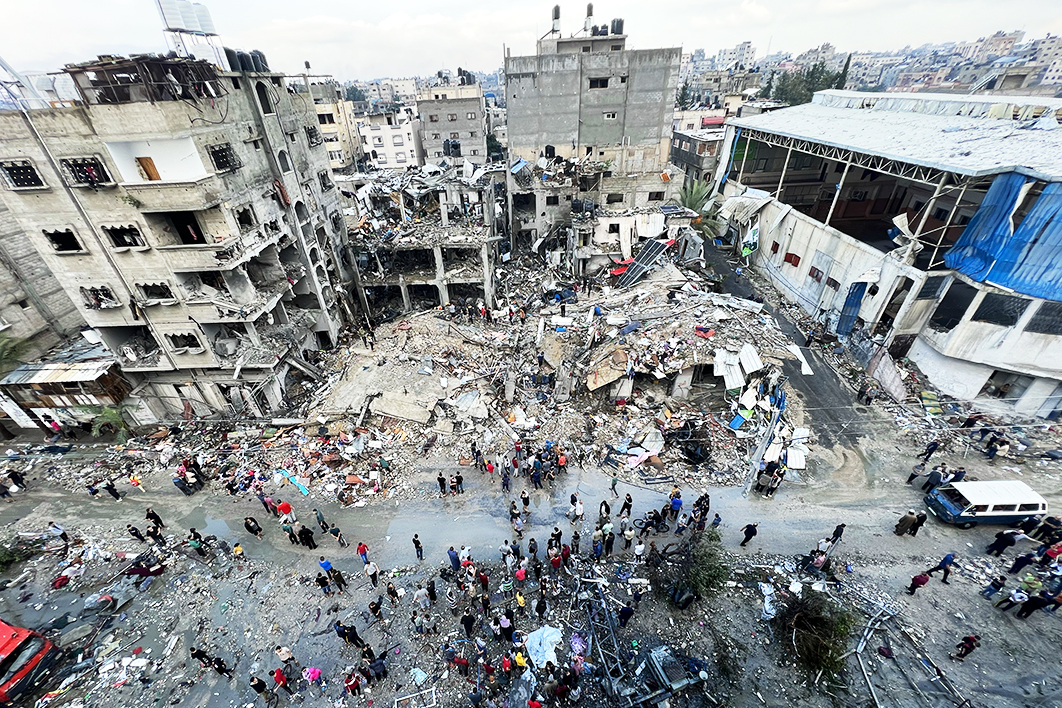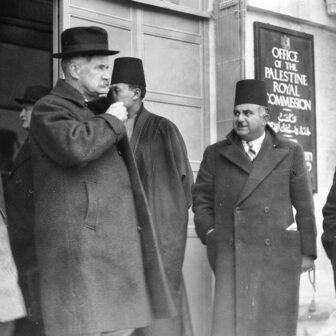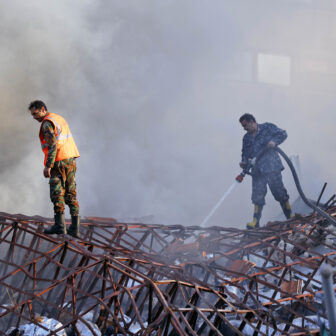“The day after” has been a phrase dropping from the lips of those peering into a future that will be scarred by one of the most brutal conflicts in modern history. The day after! What does the phrase actually mean? Does it amount to a glib and clichéd attempt to divert attention from the reality of a war that is exacting a terrible toll?
From the 7 October Hamas pogrom against Jewish residents on the borders of the Gaza Strip to the obliteration of much of the civilian infrastructure of North Gaza by Israel in retaliation, this is a merciless conflict. How will it end so that the “day after” question can begin to be answered?
The short answer is no one knows how this war will end, nor how many will be killed beyond the 1200 Israelis who have perished and, according to Gaza’s health ministry, the 11,000 Palestinians. These are the raw numbers, but they hardly reveal the extent of the destruction of a Palestinian enclave of 2.3 million people in a narrow strip of land on the Mediterranean, and nor do they account for the extent of the trauma experienced by both sides.
The day after will not simply involve a reckoning of casualty figures or physical destruction, but will also leave a traumatised Palestinian population in Gaza and an Israeli population haunted by what happened on 7 October. These are wounds that will not be healed for generations, if at all.
All wars end sooner or later, even the Hundred Years’ war, but in the case of the Gaza war it is hard to envisage how this conflict can be brought to an end in a way that will avoid further conflict in that conflict-ravaged space between the Jordan River and the sea.
Israel’s stated aim is the complete destruction of Hamas, its leadership inside Gaza, its military infrastructure and indeed its ability to reconstitute itself as a viable player. Whether this is achievable remains to be seen, since Hamas is not simply a military organisation to be defeated in the field. Like the Irish Republican Army it has a political wing and, most definitely, an ideology, whatever we might think of it.
The Israeli government has said repeatedly that what happened on 7 October means it won’t deal with Hamas, not now and not ever. What it has not made clear is the sort of arrangement that might satisfy it in Gaza once the shooting stops.
Will Israeli forces occupy Gaza and oversee the toxic aftermath of war? Will a global community shocked by the ferocity of the conflict mount a peacekeeping operation under a United Nations supervised trusteeship or some other such arrangement? Who will be responsible for the enormous cost of reconstruction that will run into billions of dollars?
Only those with direct experience of a war-ravaged wasteland pulverised by the most intensive bombing campaign since Richard Nixon’s carpet-bombing of North Vietnam in 1972 can have any idea of the extent of damage wrought by modern weaponry. Would Israel, in any case, be prepared to hand over the governance of what remains of Gaza to a depleted and discredited Palestinian Authority in faraway Ramallah in the West Bank?
Israel’s prime minister Benjamin Netanyahu has said Israel won’t be yielding responsibility for Gaza to the PA. He deflects questions about the circumstances in which Israel would remain in Gaza.
In any case, it is unlikely that any of this will be within his control. Politically, Netanyahu is a dead man walking given the degree of disapprobation with which he is regarded by Israelis, who blame him for security failures that enabled the 7 October attack in the first place.
PA leaders have said they won’t be reasserting responsibility for Gaza in present circumstances, weakened as they were by the election there in 2006 and having yielded control altogether to Hamas the following year. They have said they will certainly not be re-entering Gaza on the “back of an Israeli tank.”
Then there is the overarching question of whether the savagery of the Gaza conflict will bring about a full-on attempt, backed by the United States, the European Union, Arab states and the United Nations itself, to force-feed a political settlement more broadly to Israelis and Palestinians?
Here, we are talking about a two-state solution in which the Palestinians would be granted a state of their own behind secure borders in exchange for peace. This was the aim of the Oslo process of 1993–95 that delivered an agreement between Israel and the Palestine Liberation Organisation designed to lead to a permanent settlement after a transitional period.
The breakthrough agreement was consummated in 1993 by Israel’s prime minister Yitzhak Rabin and PLO leader Yasser Arafat in the presence of US president Bill Clinton on the White House lawn. Two years later, before the Oslo process took root, Rabin was assassinated by a Jewish zealot opposed to peace with the Palestinians. That terrible moment, whose main political beneficiary was Netanyahu, effectively killed a nascent peace process.
In the generation since, attempts have been made by successive presidents to re-energise the peace process, Clinton at Camp David in 2000; Barack Obama in the early stages of his presidency before he foundered on Israeli obduracy and Palestinian fecklessness; George W. Bush, half-heartedly, at Annapolis in 2007; and Donald Trump with his “deal of the century” that was no deal at all as far as the Palestinians were concerned.
The Trump administration’s strategy was to persuade Arab states, principally Saudi Arabia, to make peace with Israel. The Palestinians would then be left, the strategy proposed, with little choice but to fall into line — in other words, to accommodate themselves to whatever morsels were left to them. This process was marketed by Trump as the “Abraham Accords,” as if the memory of the revered Jewish patriarch would cast a biblical spell over the region.
Among Hamas’s clear aims on 7 October was to derail that process. In that regard it has succeeded for the time being, but in the longer term it may have galvanised an international community to actually try to do something about the issue beyond mouthing empty platitudes about a “two-state solution.”
The next question is why Hamas chose to attack Israel in the way it did in the certain expectation that retaliation would be brutal and the civilian population of Gaza would bear the brunt. The answer is complex but might be explained by a nihilistic terrorist mindset that pays less attention to the consequences than to the act of terror itself.
Hamas’s branding of its military operation by reference to the violation of Jerusalem’s Al-Aqsa mosque by an extremist member of Netanyahu’s cabinet underscores the jihadist component of what took place. But beyond all this is the possibility that Hamas may have hoped to provoke a regional conflict involving Israel in a several-fronts war with Hezbollah in Lebanon and with Syria in the north, and may even have believed Iran could be drawn into the conflict.
None of this, apart from fairly desultory rocket salvos from Hezbollah in northern Israel, has come to pass. US president Joe Biden’s decision to deploy two aircraft carrier battle groups in the region was aimed at forestalling a wider conflict. It appears to be working, for the time being.
As Israel continues to dismember what is left of the northern section of Gaza, which had been home to one million Palestinians, we come closer to the existential question: what next when, and if, the guns fall silent over a wasteland?
Having lived in the Middle East for many years, having reported from Israel and the occupied territories and having written a book about Israel–Palestine, I find it hard to be optimistic about a resolution of the longest-running conflict in modern history. For the sake of argument, though, let’s consider a scenario that harks back to the lost opportunities following the PLO’s recognition of Israel’s right to exist, as dramatised by the Rabin–Arafat handshake on the White House lawn in September 1993.
Under this optimistic, even improbable, scenario, America would lead a comprehensive process to impose a settlement on Palestinians and Israelis that would enable the two sides to accommodate each other in separate states living in relative harmony side by side. The contours of such an arrangement were negotiated up hill and down dale in the 1990s, with territory to be set aside for land swaps to compensate the Palestinians for Jewish settlements contiguous to Israel that could not be dismantled under any reasonable circumstances.
An agreement with the Palestinians would have four main pillars: the putative state of Palestine would be demilitarised, Palestinians would not have the right of return to Israel proper among families displaced in 1947–48, settlements on the boundaries of Israel would remain in place and, tackling the thorniest issue of all, East Jerusalem would be the Palestinian capital under a shared sovereignty with Israel over the Holy places. Jerusalem would be left for “final status” talks, in other words the concluding chapter of a peace settlement.
When those bare-bones details are exposed, what becomes apparent is how difficult, if not impossible, a comprehensive settlement would be. The above was more or less on the table — without the Jerusalem issue being close to being resolved — at Camp David in 2000 and in a final desultory attempt by the Clinton administration at Taba in 2001 before Bush was inaugurated.
What has happened in the meantime to further complicate the picture? Quite simply, a very great deal has transpired to make realising a two-state solution even more complicated, if not impossible. This might be described as the multidimensional Middle East Rubik’s cube.
For a start, Israel’s settlement-building in territory occupied in the 1967 Six Day war has continued apace. By 2022, Israel had 199 settlements and 220 outposts in the West Bank with something like 500,000 settlers on land occupied in 1967. Under international law those settlements on territory seized by Israel in 1967 are illegal; even Israel itself regards many of the small settler outposts as renegade establishments.
On top of that are the 250,000 Israeli residents of East Jerusalem. That adds up to three-quarters of a million Israelis who would be anxious about, if not bitterly opposed to, any peace settlement that involves relinquishing those areas.
Under present circumstances Palestinians in the West Bank and East Jerusalem are subject to military rule and don’t enjoy the same civil and political rights as Israeli settlers. Human rights groups describe this as apartheid.
This is the reality of 2023. It is one of the main reasons why there are many advocates for what is described as a one-state solution, in which Israelis and Palestinians live side by side in a single state with equal rights. This is not an outcome that would be favoured by most Israelis, and certainly not those on the nationalist settler right. It is not idle to say that the country would risk falling apart on the concessions that would be required to secure an honourable settlement.
Here it might be useful to clarify a misunderstanding surrounding the failure of Camp David in 2000. Arafat got, and deserves, much of the blame for its failure; the Palestinians were deeply divided on the concessions required for an agreement. But blame should also be attached to the Americans for poor preparation of the process, and to Israeli prime minister Ehud Barak, who refused to meet Arafat one-on-one at Camp David.
What is often overlooked is that it was not in Barak’s gift to deliver an agreement without strings attached. He had undertaken to take the Camp David II formula to a vote of his compatriots with no certainty of a positive outcome.
If the lessons of Oslo and the other attempts at Middle East peace tell us one thing, it is that no positive outcome will come without American leadership, and not simply leadership but a willingness to take control of the process in partnership with its allies, including Arab states fearful of further destabilisation in the region.
Does America have the time and energy for such a process given challenges it faces from China in the Indo-Pacific and from Russia on NATO’s western flank, not to mention a domestic political environment that could hardly be less stable.
America and its allies have always been at pains to say it is up to the protagonists to make peace. A settlement cannot be force-fed. In light of what has happened since 7 October the question becomes whether the West in partnership with Arab states can afford to allow the situation to continue to fester.
American supporters of the Israeli settler right would certainly mobilise against a process that involved widespread dismantling of settlements. Yet no agreement will be possible without a comprehensive arrangement that respects Palestinian sovereignty, removes impediments to freedom of movement in a West Bank desiccated by settlements and, most likely, creates a secure and elevated transit route between the West Bank and Gaza that itself would need to be open to the outside world.
Only a supreme optimist would believe that all this will come to pass in very many days after the guns fall silent, and certainly not “the day after,” but it is the only plausible scenario that has emerged so far. •




